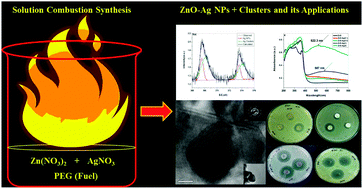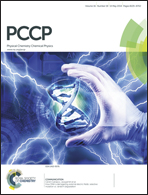Spectroscopic dimensions of silver nanoparticles and clusters in ZnO matrix and their role in bioinspired antifouling and photocatalysis†
Abstract
Silver doped zinc oxide nanoparticles are synthesized by a solution combustion method. The samples characterized by a variety of spectroscopic and other techniques clearly reveal the presence of silver nanoparticles as well as silver clusters. The silver in the two forms was identified by careful deconvolution of X-ray photoelectron spectral results. Their formation was also confirmed by the presence of plasmons, the concentration and energy of which increase on increasing silver input, indicating the presence of perpendicular excitons since aggregates of clusters are known to shift the plasmon resonances depending on their topologies. Further confirmation of clusters came from EPR (electron paramagnetic resonance), HRSEM (high resolution scanning electron microscopy) and HRTEM (high resolution transmission electron microscopy); direct proof for clusters came from matrix assisted laser desorption ionization-time of flight (MALDI-TOF) mass spectral measurements. The antimicrobial activity of the silver doped zinc oxide polymer nanocomposites as biomedical devices are measured by zone of inhibition. Also, samples coated on paper disk with acacia binder are evaluated by a disk diffusion method. While pure zinc oxide does not show any antimicrobial property, the activity of silver-doped zinc oxide is comparable to that of commercial antibiotics and found to be related to nanoparticulate silver. Similarly, the microbial adherence to the surface of polymer nanocomposite which mimics a biomedical device also was influenced by nanoparticles of silver. The photocatalytic water treatment was carried out using silver carrying nanoparticles with Rhodamine-B and 4-chlorophenol as model pollutants. The increased photocatalytic activity of silver containing zinc oxide as compared to pure zinc oxide nanoparticles is attributed to the synergistic display of the properties of silver nanoparticles and clusters in zinc oxide. This activity depends upon the dispersion of silver nanoparticles over the zinc oxide lattice where charge separation plays a dominant role. The mechanisms for both photocatalysis and antimicrobial activity are discussed.


 Please wait while we load your content...
Please wait while we load your content...